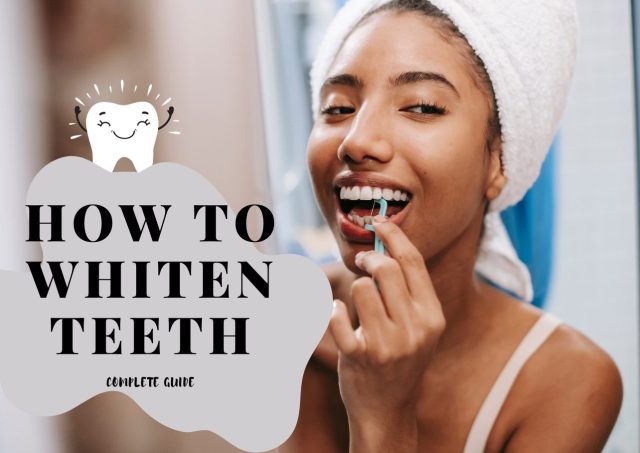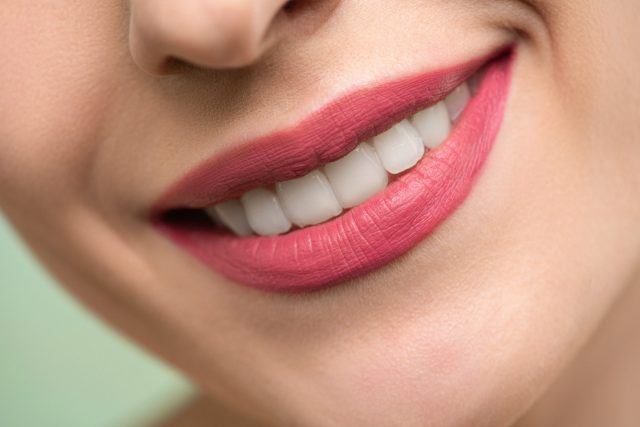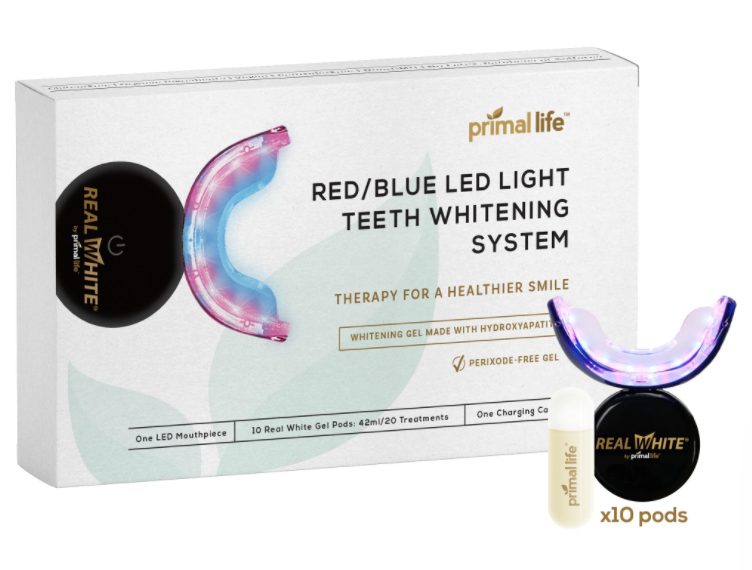How To Whiten Teeth: Complete Guide 2024
By Vanessa Richards
January 10, 2024 • Fact checked by Dumb Little Man

Most people are quite self-conscious about their looks, especially when it comes to their smiles. Central to a healthy and bright smile is a dazzling set of white teeth.
Your pearly whites are more than just a tool for chomping down on food. They are an important part of your appearance and one of the first things people notice about your face.
Unfortunately, many different things can stain your teeth and lead to unsightly discolorations. This includes acidic foods, beverages, drugs, lifestyle choices, and poor oral hygiene.
In this article, we’ll explore different types of dental stains, teeth whitening treatments, and how to safely brighten your smile. Let’s look at the methods, risks, and questions involved in teeth whitening.
Types of Teeth Stains
To fully understand why it seems like some people develop surface stains on their teeth while others don't, it's important to first understand the basic structure of a tooth.
A tooth has three basic layers, the innermost pulp, the middle dentin, and outer enamel.
At the core of a tooth is the pulp, which is a collection of blood vessels and nerves. Over this is the dentin, which has a slightly yellowish hue.
It is responsible for the natural slightly yellow color of the teeth. The outermost layer of the tooth is the semi-translucent enamel, the strongest substance in the human body.
One possible cause of yellow teeth is when the outer enamel wears away (also called enamel erosion). Since the underlying dentin had a yellowish color, an individual’s teeth can appear yellow if they have abnormally thin enamel.
Another cause can be the staining of the teeth due to dyes and compounds found in certain substances. There are three types of teeth stains.
- Extrinsic stains are commonly caused by lifestyle choices and consuming certain foods and drinks. Extrinsic stains discolor the outer surface of the teeth (the enamel).
- Intrinsic stains occur within the teeth and discolor the dentin of the teeth. They are usually caused by medications, tooth decay due to poor oral hygiene, trauma, and excessive fluoride use. They are usually much more difficult to treat than extrinsic discoloration.
- Age-related stains are usually a combination of extrinsic stains and intrinsic stains, as well as enamel thinning.
What Are the Common Causes of Stained Teeth?
Let’s take a look at a few common causes of discolored teeth.
- Overindulging in certain foods and beverages like soft drinks, sour foods and candies, and fruit drinks because they contain weak acids which gradually eat away at your enamel layer
- A diet that is high in processed sugars and starch because they encourage bacterial growth which produces acids that eat away at the enamel
- Acid reflux disease (heartburn)
- Poor oral hygiene, which can also lead to tooth decay and gum disease
- Drugs like aspirin, vitamin C, and antihistamines
- Teeth grinding
- Alcohol abuse, binge drinking, and bulimia because the frequent vomiting associated with these habits wear away the enamel
- A condition is known as xerostomia, which means an abnormally dry mouth
- Genetics
- Other things can stain teeth due to certain compounds or dyes they possess such as teas, cigarettes, cola, chewing tobacco, and other staining foods
How To Whiten Your Teeth

Now that we know a few things that can lead to discolored teeth, it’s time to delve into a few popular whitening options you can use to brighten your teeth. These range from popular natural remedies to medications and even new emerging technologies.
DIY Methods
Here are some easy DIY methods of teeth whitening you can carry out without having to visit a dentist’s office.
Activated Charcoal
Activated charcoal is a finely grained powder made from certain natural substances like coconut shells, petroleum coke, olive pits, charred bones, slowly burned wood, and peat. It is used as a natural tooth whitening method because it is believed that the pure powder helps absorb teeth stains.
However, there is no scientific evidence supporting this claim. Research from the American Dental Association (ADA) has shown that mild abrasives like activated charcoal may be harmful to your teeth.
Baking Soda
Baking soda is another popular tooth whitening technique because it is believed to be a natural bleaching agent. It is a common household item that is made from a mixture of bicarbonate and a weak acid.
While some dental products may contain small amounts of baking soda, applying the raw powder to your teeth is not a good idea. Baking soda is a mild abrasive and may wear away the enamel of your teeth, leaving you with bigger issues.
Oil Pulling
Oil pulling is an ancient alternative medicine practice that involves swishing small quantities of oils such as olive oil, coconut oil, or sesame oil in your mouth to improve dental health. There is some evidence that the practice may kill bacteria and increase saliva production, which in turn helps improve your oral health.
Oil pulling may be helpful in certain conditions like mouth odor, cavities, gum disease, and gum irritation. However, currently, there is no scientific research supporting its use as a teeth brightening agent.
Hydrogen Peroxide
Hydrogen peroxide is a commonly used household item that is also used in a wide range of tooth whitening products. It is one of the few DIY methods of tooth whitening which have been scientifically proven.
The problem is that most available solutions of hydrogen peroxide are diluted to about 3 percent, while concentrations as high as 10 percent are used in whitening treatments. However, lower concentrations of hydrogen peroxide may be safer as studies have found the higher concentrations used in such products can cause significant damage to your enamel.
The only disadvantage is that using lower concentrations requires you to use the product for much longer before you notice significant results. A good way of using dilute OTC solutions of hydrogen peroxide is to swish a small quantity in your mouth for a few minutes before spitting it out and then rinse your mouth with water.
Remember not to swallow any of the hydrogen peroxide as it can lead to some unpleasant side effects.
>> Related Article: 10 Easy Ways to a Whiter Teeth Without Spending Too Much
Whitening Systems
Let’s take a look at a few dental products and medications you can pick up over-the-counter (OTC) or which your dentist may recommend to help you achieve whiter teeth.
Whitening Strips
Whitening strips are popular teeth whitening products that can be bought over-the-counter without having to visit a dentist. Most strips contain chemicals like carbamide peroxide or hydrogen peroxide, which are great for brightening your smile.
Simply apply the strips over your teeth and leave them on for the specified amount of time. They are safe, cheap, and quite effective.
However, some people do experience adverse effects. Effects such as tooth sensitivity, gum irritation, and even enamel damage.
Rinses
Most people are already familiar with the various brands of fluoride-based mouthwashes available. However, rinses for brightening the teeth typically contain peroxide additives such as hydrogen peroxide or carbamide peroxide which help whiten the teeth.
These rinses promote good oral hygiene too and are usually used several times a week along with other good dental hygiene practices such as brushing and flossing.
Whitening Gels
Teeth whitening gels work the same way as whitening strips. They contain a brightening agent (usually hydrogen peroxide) and are applied as a thin layer over the teeth.
They can be left for several minutes before being rinsed off. However, it may take several applications before any noticeable changes occur.
Whitening Toothpaste
Whitening toothpaste is another easy OTC method you can use. Most types of whitening toothpaste are mild abrasives that help gently remove surface stains from your teeth.
They also contain brightening agents such as hydrogen peroxide. Together these two mechanisms work to brighten your teeth by up to a shade or two.
Tray-based Teeth Whiteners
Tray-based teeth whiteners are an effective teeth whitening system that makes use of a mouth guard-like structure filled with a teeth brightening solution or gel (usually one which contains hydrogen peroxide).
These trays are then worn for several hours a day (typically at night) for several days to weeks depending on the degree of discoloration. They are quite effective and can be picked up from a pharmacy for relatively a cheap price. Pricier custom-made designs can also be purchased at a dentist’s office.
Other Treatments
Now let’s take a look at a few other available teeth whitening options.
LED Treatments
LED teeth whitening treatments involve using a special LED light or laser to speed up the whitening effects of dental bleaching agents like hydrogen peroxide. The dental products are simply applied to the teeth then an LED light is focused on them to speed up the bleaching process.
Initially, this treatment was only available at dentist's offices and was quite expensive, but with newer, cheaper, and more portable forms of the technology are now widely available.
1. Fastest Teeth Whitening Solution: The Primal Life Organics V3 LED Teeth Whitening System
The Primal Life Organics V3 LED Teeth Whitening System is a top-notch LED teeth whitening system that has tons of benefits. The product contains one LED teeth whitener with 32 bulbs (16 blue and 16 red bulbs), a magnetic charging wire, and one 10ml syringe of Real White Gel.
Let’s take a look at some of the features which set this LED whitening system ahead of the pack.
- It uses 32-bulb dual system LED light technology with the traditional blue LED lights to speed up the teeth whitening process and red LED lights to promote wound healing and slow down bacterial growth.
- It comes with a durable magnetic charging wire and is completely wireless during use, making it quite convenient.
- The Real White Gel is effective, great tasting, and safe for the teeth, meaning you don’t have to worry about any nasty side effects.
- The product is durable, and a single unit can last up to 15 years with regular use.
Shop at PrimalLife Organics Official Website
Full Article: PrimalLife Organics LED Teeth Whitening System Reviews 2024: Does it Work?
In-Office Whitening Appointment
An in-office whitening appointment with your dentist is the quickest and most effective way of whitening your teeth. It typically involves applying a teeth whitening product directly to your teeth and may also involve other teeth brightening methods such as lasers, heat, or special lights.
Each session takes about 30 to 60 minutes and usually, you’ll notice visible changes after a single session. Depending on the desired results and the degree of staining several sessions may be required.
However, even though a whitening appointment with a dental hygienist is the most effective method of teeth whitening, it’s also the most expensive.
So What’s the Final Verdict?
With all these different types of teeth whitening methods, it’s hard to pick out the most effective method. Many home-based DIY methods such as apple cider vinegar, baking soda, kaolin clay, and even activated charcoal are harmful to the enamel and should be used with caution.
Also, there is little scientific evidence supporting the use of these methods as most support for these techniques is anecdotal.
On the other hand, many teeth whitening systems are effective and have significant backing from the American Dental Association. However, when used excessively they can be associated with tooth sensitivity, gum irritation, and other serious consequences.
Also, methods like mouth rinses and whitening toothpaste which only stay in contact with your teeth for a short amount of time typically take several weeks before you notice visible changes.
In-office dentist appointments are effective but quite costly. Therefore, the best teeth whitening method in terms of cost, effectiveness, and safety is LED treatments.
They produce results after several sessions, they are relatively cheap, easy to use, and due to the enhancing effects of the LED light less contact with bleaching agents is required.
Conclusion
Everyone deserves to have the smile of their dreams. Cost, safety, and effectiveness should not be a barrier for you to achieve that.
Various teeth whitening systems and natural DIY methods exist. However, overall LED whitening systems are the most reliable and cost-friendly ways of brightening your smile.
The Primal Life Organics V3 LED Teeth Whitening System is our top recommendation. This is because the product is safe, convenient, effective, and quite cost-effective.
After just a few sessions you will notice visible changes in your teeth. The revolutionary dual LED technology certainly makes it the best LED whitener on the market.
Click Here to Get LED Teeth Whitening System at a Discounted Price
>> Related Article: 7 Best Supplements and Vitamins for Gum and Oral Health in 2024
How To Whiten Teeth FAQs
How long do teeth whitening treatments take?
The length of time it takes to whiten your teeth depends on the method used. In-office appointments are usually the quickest, with visible results being possible after a single session.
Other teeth whitening systems can take anywhere from days to weeks depending on the method, strengthening of the bleaching agent, how long it stays in contact with the teeth, and the number of sessions.
Is tooth whitening safe on dentures and veneers?
No, most teeth whitening procedures or methods are not safe for dentures or veneers.
How many shades whiter can I expect my teeth to get?
This also depends on the method used. Most teeth whitening systems may only lighten your teeth several shades, while a dentist appointment may lighten your teeth up to 5-10 shades.
Vanessa Richards
Vanessa is a mom of 3 lovely children and a software geek. Outside of her career as a health and wellness instructor. She enjoys writing and researching on topics such as finance, software, health and culinary.



